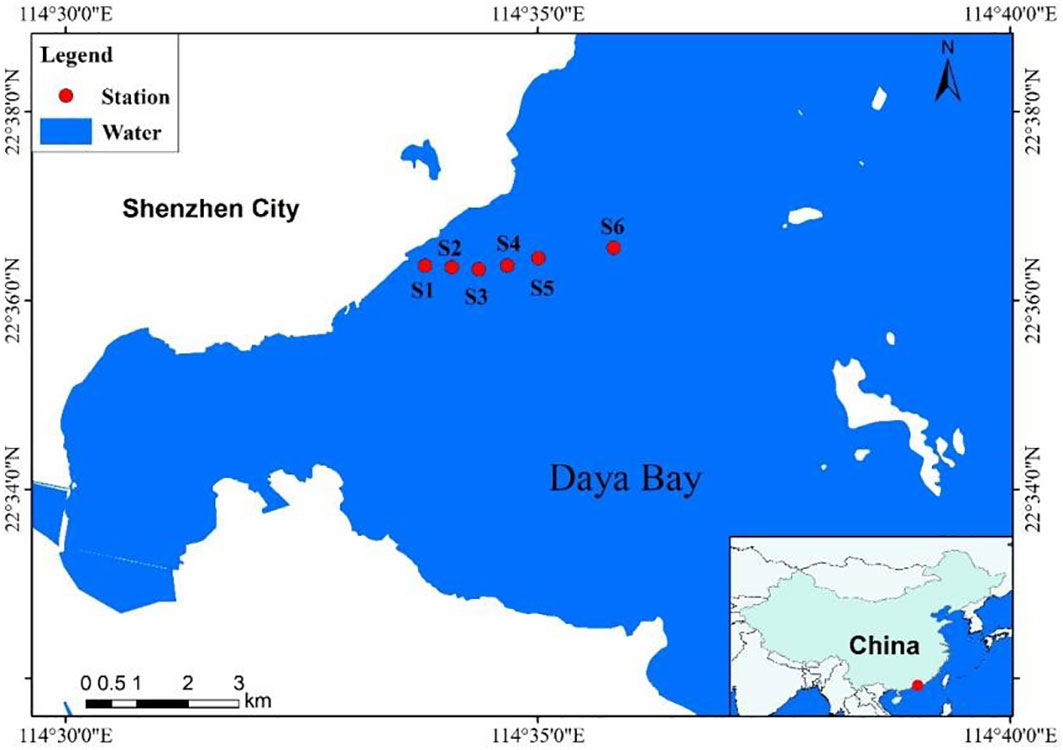- 1South China Sea Fisheries Research Institute, Chinese Academy of Fishery Sciences, Guangzhou, China
- 2Key Laboratory of Tropical Marine Bio-resources and Ecology, South China Sea Institute of Oceanology, Chinese Academy of Sciences, Guangzhou, China
- 3Hainan Eco-Environmental Monitoring Center, Haikou, China
Managing the marine ecosystem effectively requires studying the response of plankton community metabolism to warming. Moreover, warming caused by thermal discharge is known to significantly raise the water temperatures in the nuclear power plants. However, effects of thermal discharge on planktonic community metabolic characteristics, especially net community production, in surrounding waters remain poorly understood. Therefore, in this study, we aimed to analyze the characteristics of plankton community metabolism in thermal discharge area of the Daya Bay, China. The investigations were conducted in August 2016 and January 2017. Our results showed that the plankton community metabolism was promoted in moderately warm regions (29.4-30 °C), with higher gross primary production and community respiration than in high- and extremely high-temperature regions; meanwhile, plankton community metabolism was evidently inhibited in high (31.4 °C in winter) or extremely high (36°C in summer) temperature regions, thereby exhibiting heterotrophic metabolism state. Our findings indicate that warming could affect plankton community carbon metabolism in the Daya Bay, thereby declining the stability of the marine ecosystem.
1 Introduction
Plankton metabolism is a fundamental property of marine ecosystem driving the flux of gases and the transference of organic matter to the food web (Agusti et al., 2018). Marine plankton metabolic processes mainly include the gross primary production(GPP) and community respiration (Del Giorgio and Williams, 2005; Ducklow and McAllister, 2005), and directly affect the oceanic carbon cycle (Xiang et al., 2022).The key ecological processes affecting the carbon budget in marine ecosystems remain unknown, and related studies primarily focus on the response of plankton community metabolism to warming due to global climate change (Nguyen et al., 2012; Wang, 2014). Warming caused by thermal discharge could raise the adjacent water temperature in the nuclear power plant by over 8°C (Kim et al., 2007; Choi, 2008). However, effects of thermal discharge on planktonic community metabolic characteristics, especially net community production (NCP), have rarely been reported in surrounding waters.
The Daya Bay is an important subtropical semi-enclosed bay located in southern China. With the increasing number and scale of nuclear power plants in the Daya Bay, heating effect by thermal discharge is gaining attention (Teixeira et al., 2012), but the effects of thermal discharge on planktonic community metabolic characteristics in the Daya Bay remain unknown. In this study, we aimed at demonstrating the response mechanism of plankton community metabolism and carbon metabolism balance to thermal discharge.
2 Materials and methods
2.1 Samples collected and analysis
Sampling and in situ experiments were carried out in thermal discharge area from August 1 to 10, 2016, and January 4 to 13, 2017, respectively. Six sampling stations (It was named as S1-S6 in summer and W1-W6 in winter) were set along the actual temperature gradient in the adjacent area around thermal discharge outfall (Figure 1), and water depth ranged from 5 to 7m.
Water samples were collected using a 5L niskin bottle at the surface layer, and environmental factors (temperature, salinity and pH) were measured simultaneously using a YSI 6600 multi-parameter water quality monitor (Yellow Springs Instrument Co., USA) at each sampling site. After collection, the water samples (0.5L) for inorganic nutrients and chlorophyll a (Chl-a) determination were filtered on GF/F filters (Whatman). Moreover, the water and filters were preserved at -20°C in the darkness before further processing in the laboratory. The nutrient (nitrate, nitrite, ammonia, and phosphate) concentrations were analyzed using a nutrients-analyzer (Quickchem 8500, USA) according to Kirkwood et al. (1996). Chl-a concentration was also measured using a Turner Design 10-AU fluorometer according to Parsons et al. (1984).
2.2 In situ plankton metabolism experiment
The planktonic community metabolic rates (GPP; NCP; and community respiration, CR) were estimated from the changes in dissolved oxygen concentrations in the light–dark bottles over a 24-h incubation period following Serret et al. (1999). Each temperature gradient has three duplicate samples, and DO was measured at the 0 h and 24 h of incubation period by Presens precision sensing Microx 4 Oxygen meter with a detection limit of 0.01 mg/L and detection accuracy of ±0.025 mg/L.
2.3 Data analysis
Pearson analysis was also performed to detect the relationships between metabolic rates and Chl-a using the SPSS software. The metabolic rates and their responses to biotic and/or abiotic factors were elucidated with canonical correspondence analysis (CCA). The CCA analysis was conducted using the statistical program, CANOCO version 4.5 (Chen et al., 2011).
3 Results
3.1 Environmental characteristics
Environmental parameters in both seasons are shown in Table 1. In summer, sea surface temperature decreased along the transect and ranged from 29.5 to 36°C in summer, with a temperature difference of 6.5°C. Sea surface salinity exceeded the value of 33 in the entire study area. Dissolved inorganic nitrogen (DIN) concentration ranged from 6.15 to 8.72 μmol·L-1, and dissolved inorganic phosphate (DIP) concentration ranged from 0.05 to 0.18 μmol·L-1. Chl-a concentration ranged from 0.66 to 1.72 μg·L-1, and Chl-a was highly concentrated at S4 and S5.
In winter, the sea surface temperature decreased from 23.2 to 31.2 °C, with a temperature difference of 8°C. The value of sea surface salinity was found to be < 28 in the entire study area. DIN concentration ranged from 13.05 to 22.90 μmol·L-1, whereas DIP concentration ranged from 0.15 to 0.26 μmol·L-1. Chl-a concentration ranged from 0.16 to 0.51 μg·L-1, with high concentrations at stations W5 and W6. The atomic ratio of DIN/DIP in thermal discharge area between summer and winter was 16:1, suggesting a potential phosphorus limitation.
3.2 Plankton community metabolism
In summer, CR increased slightly with increasing temperature. Moreover, GPP and NCP increased with warming (Figure 2). GPP and CR were highest in the temperature range of 30.0-31.0°C, with values of 641.25 and 78.75 mgC·m-3·d-1, respectively, and the metabolic balance of the plankton community was in the positive state. In contrast, GPP and CR were lowest in extremely high temperature regions(34.0-36.0°C), declining to 7.50 and 52.50 mgC·m-3·d-1 respectively, and the community metabolic rate was in a state of negative metabolic balance.
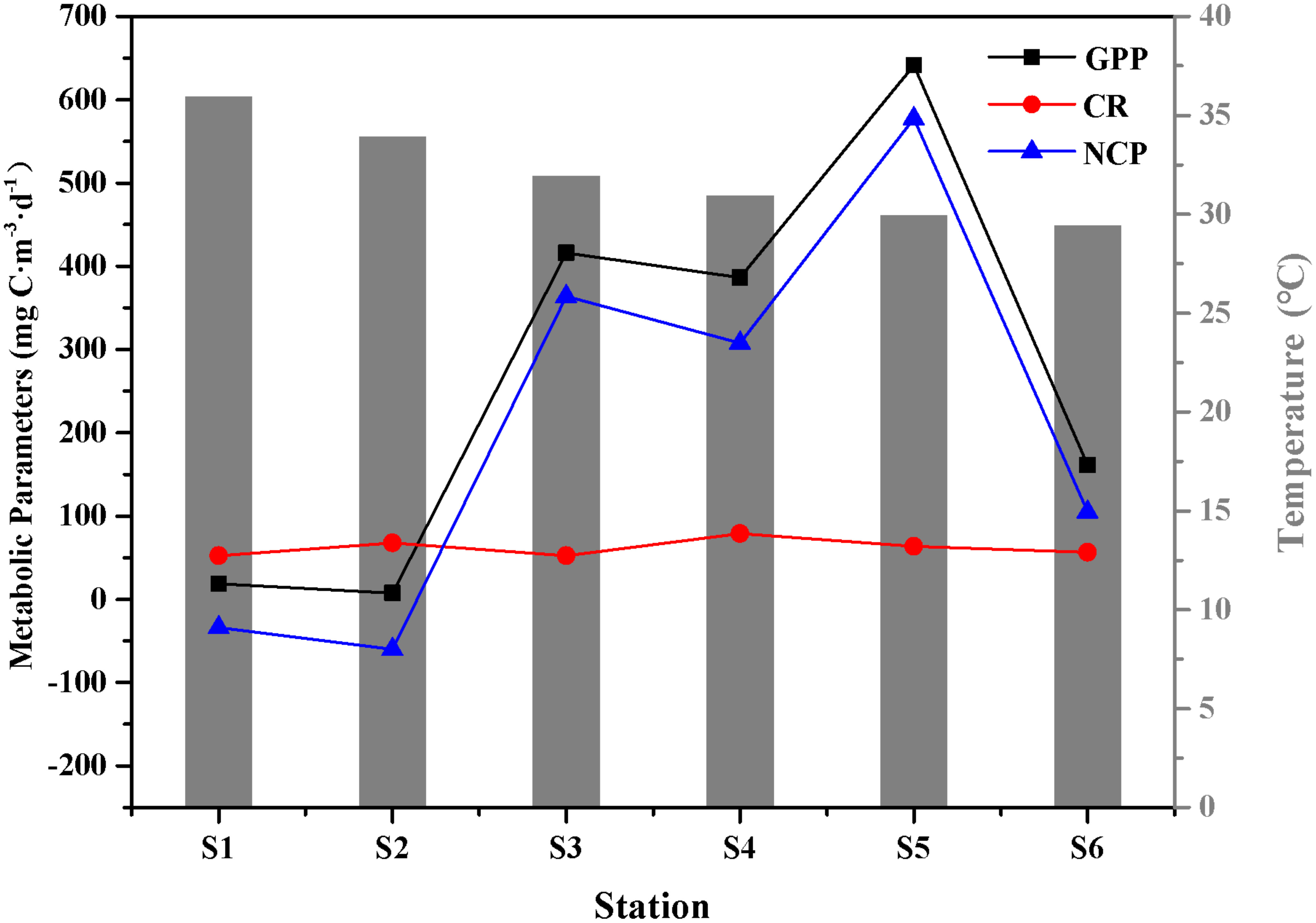
Figure 2 Features of plankton community metabolism during summer.Changes in CR are shown in red line and symbols, in NCP in blue line and symbols, and in GPP in black line and symbols, over time. CR, community respiration; GPP, gross primary production; NCP, net community production.
In winter, CR and GPP increased firstly and then decreased with warming (Figure 3), with maximum values of 300.00 and 112.50 mgC·m-3·d-1, respectively. Plankton community metabolism was in a negative metabolic balance state.
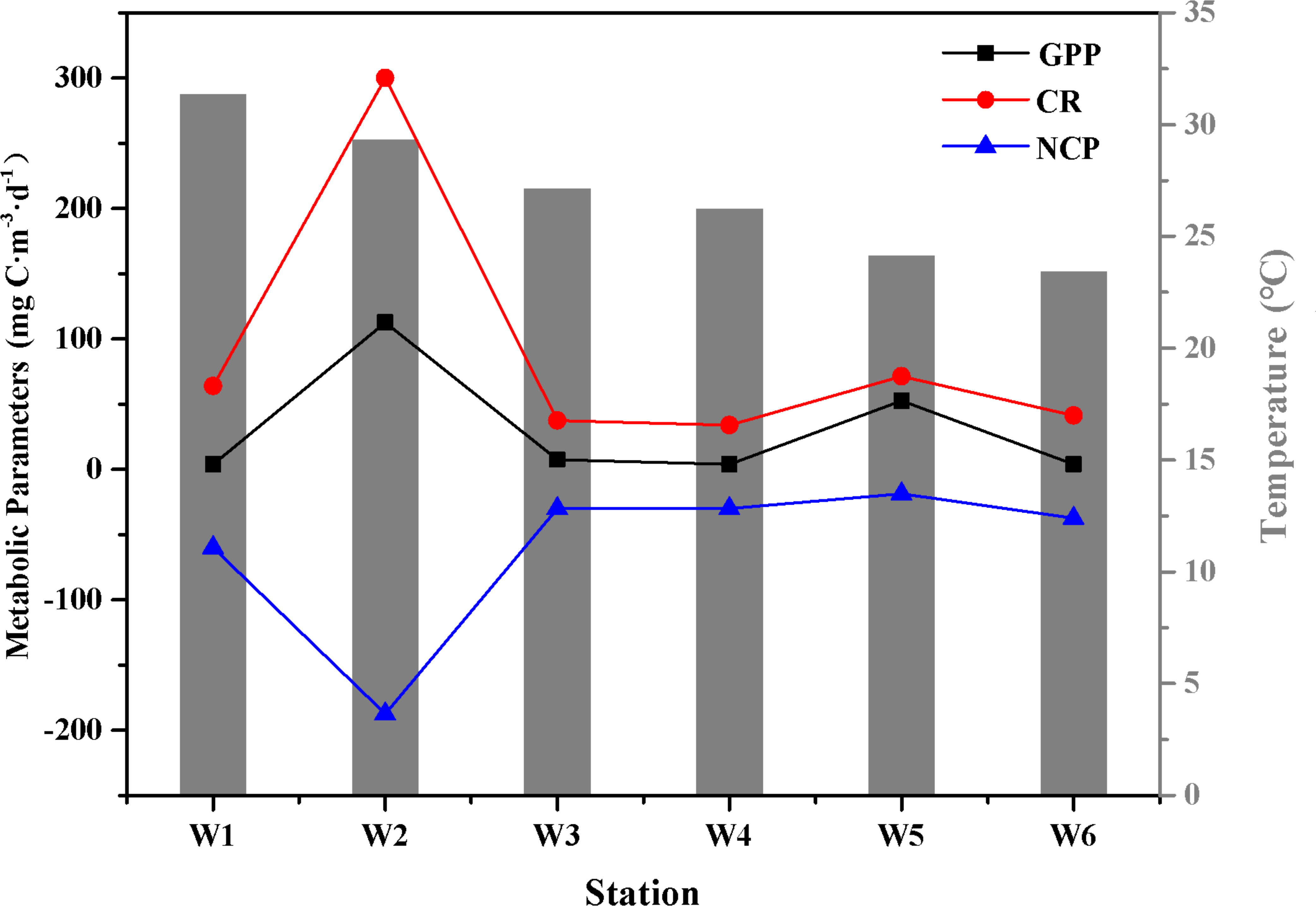
Figure 3 Features of plankton community metabolism during winter. Changes in CR are shown in red line and symbols, in NCP in blue line and symbols, and in GPP in black line and symbols, over time. CR, community respiration; GPP, gross primary production; NCP, net community production.
The study areas showed autotrophic metabolic characteristics in summer, except for the extremely high temperature water regions (34–36°C), and plankton community production was higher in summer than in winter. On the contrary, the entire study area showed heterotrophic negative metabolic trend in winter, and respiration rates of communities in winter were higher than those in summer.
3.3 Relationship between plankton community metabolism and environmental parameters
The results of CCA are illustrated in Figure 4. In summer, GPP and Chl-a were positively related to salinity (PSU) and temperature (T), respectively. In winter, CR and Chl-a were positively correlated with temperature (T) and salinity (PSU), respectively. CCA showed that changes in temperature and salinity affected GPP and CR. Moreover, Pearson analysis showed that Chl-a concentration was positively related to GPP and NCP (Figure 5).
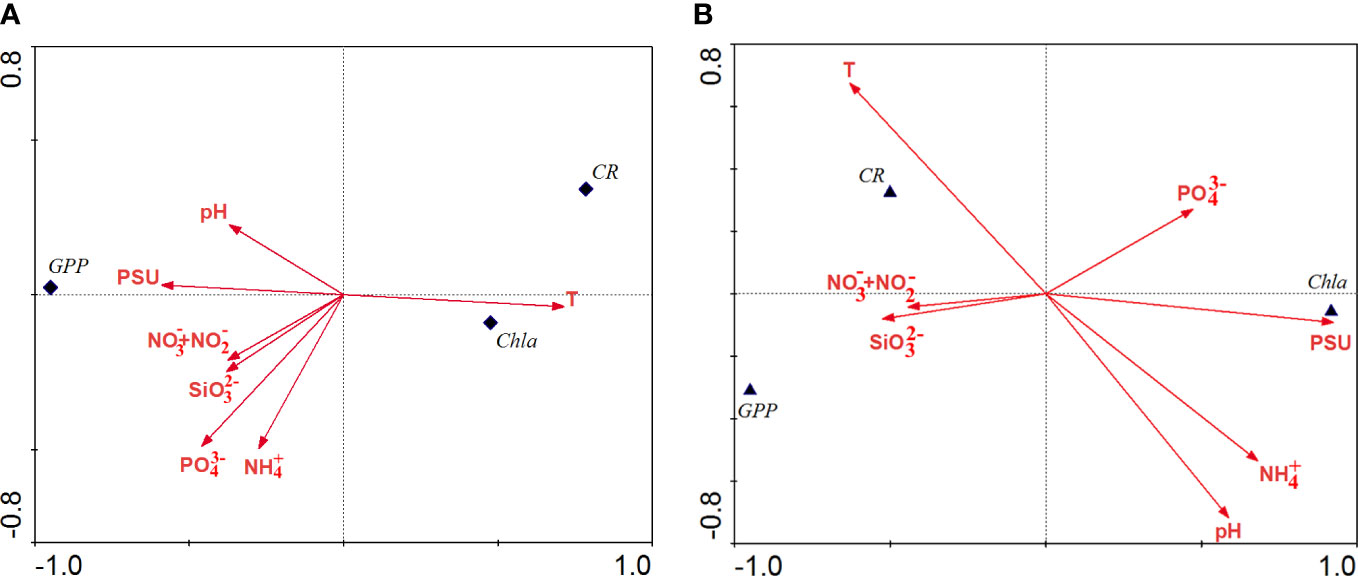
Figure 4 Canonical correspondence analysis between ecological parameters and environmental factors. (A) summer. (B) winter. Chl-a, chlorophyll a; CR, community respiration; GPP, gross primary production.
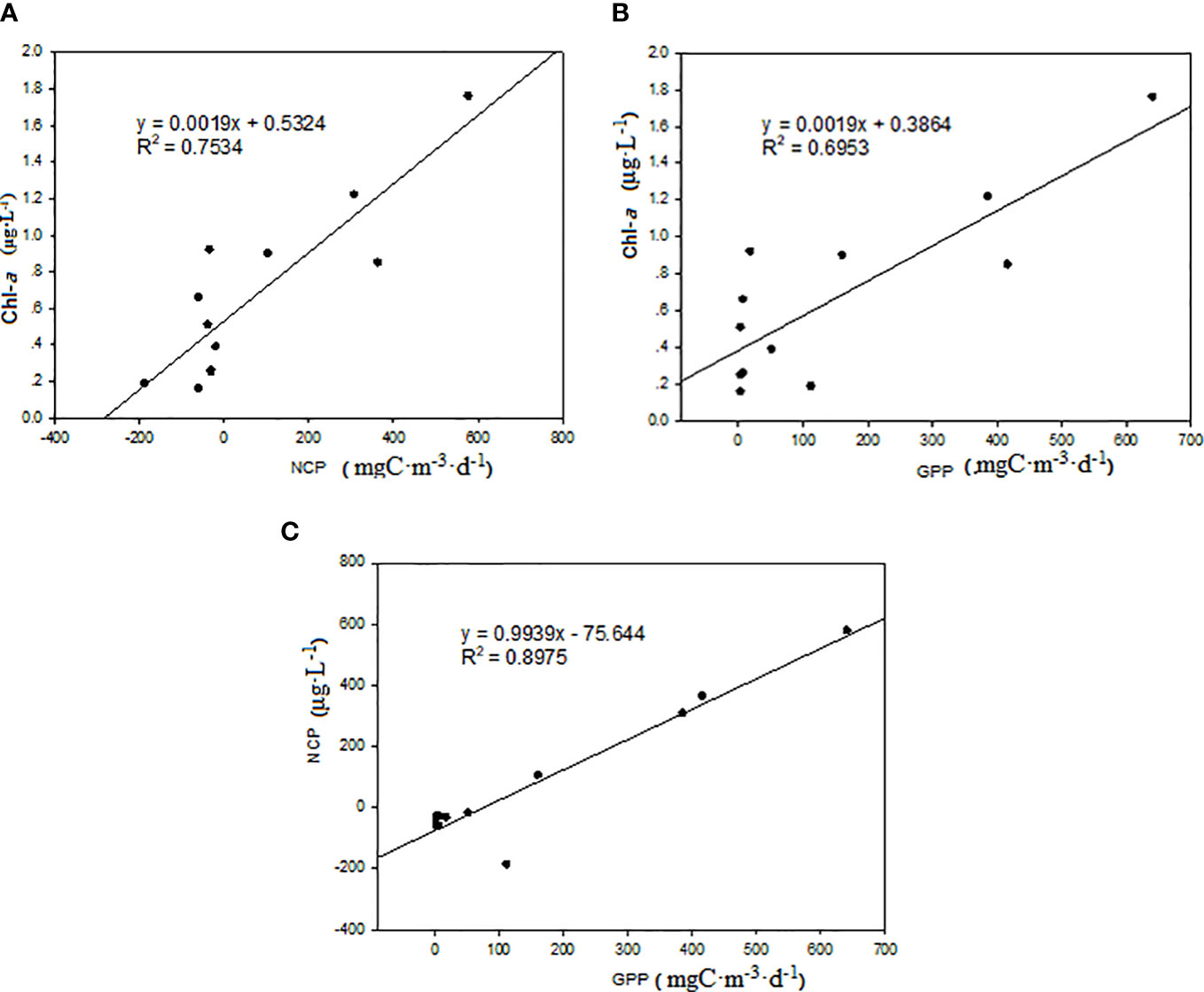
Figure 5 Pearson analysis between ecological parameters and environmental factors (A) Chl-a-NCP. (B) Chl-a-GPP. (C) NCP-GPP). Chl-a, chlorophyll a; GPP, gross primary production; NCP, net community production.
4 Discussion
4.1 Effect of warming on plankton community metabolism
When NCP > 0, primary productivity was higher than the respiratory rate, and the ecosystem exhibited an autotrophic state, acted as a CO2 sink, and stored or exported the organic matter. In contrast, when NCP < 0, respiratory consumption exceeded primary productivity, and the ecosystem exhibited a heterotrophic state and acted as a CO2 source that required storage or demineralization by exogenous organic matter input to maintain carbon source (Duarte and Regaudie-de-Gioux, 2009; Duarte et al., 2013). Ecological metabolism theory states that warming could regulate GPP and CR of plankton community. Primary production and respiratory metabolism are evidently impacted by temperature (Brown et al., 2004; Wang, 2014; Vaquer-Sunyer et al., 2015). Warming accelerates the levels of plankton GPP and CR to some extent (Aurore, 2010). In our present study, the result indicated tha plankton community metabolic rates were significantly inhibited and GPP was lower at extremely high temperatures (36 °C in summer or 31.4 °C in winter) than at moderate warm temperatures, indicating a heterotrophic metabolic state. To the best of our knowledge, this is the first study to report the phenomenon of inhibiting community metabolism in extremely high-temperature conditions.
The primary mechanism results from a rise in warming that facilitates the enzyme activity in plankton or accelerates the recycling of dissolved organic matter, thereby speeding up community metabolic rate. Extremely high temperature could inhibit enzyme activity and destroy the structure of thylakoid, thereby leading to suffocation of phytoplankton photosynthesis, growth inhibition of zooplankton, and declination in plankton community metabolic rate (Wohlers et al., 2009). Response of community metabolic process to warming is consistent with the results of previous reports in the range of optimum temperature, as community metabolic rate between summer and winter was strongest in optimum temperature areas (29–30°C), and the ecosystem showed a autotrophic metabolism state. In general, results of in situ investigation showed that planktonic community metabolism exhibited regularly varied characteristics along with variations of temperature gradient. In the field thermal discharge areas, regional distribution and driving mechanism of plankton community metabolism are relatively complex due to the existence of dynamic processes between thermal discharge outward flowing and the external water mixing and the potential impact of the entrainment effect on nuclear power plant prior to discharge.
4.2 Seasonal variation of plankton community metabolism
Temperature and nutrients are key factors affecting the planktonic community metabolic levels, as well as incidence on gross primary production and respiratory metabolism (García-Martín et al., 2014). The potential variation of the environmental factors is related to seasonal differences in the environmental background of the Daya Bay. Seasonal variation, mainly attributed to the high temperature in summer, easily results in stratification, leading to the formation of a high-temperature–high salinity stable water mass, with low contents of phosphate and DIN. At extremely high temperature conditions, dramatic warming could impact physiological processes such as enzymatic reactions or respiratory reaction intensity of photosynthesis and inhibit GPP levels in short term (Regaudie-de-Gioux and Duarte., 2012). However, plankton exhibited rapid propagation and growth trend with sufficient nutrients that were adapted to the high-temperature environment. In winter, seawater temperature was low, vertical mixing of seawater was drastic, and nutrients in the upper waters were replenished and accumulated constantly by vertical mixing. In the context of low temperature and high nutrients, concentrations of CR and GPP were influenced by warming. Therefore, the effects of warming on plankton community metabolism were more significant than those of nutrient input in winter, giving rise to seasonal differences of the two environmental factors between temperature and nutrients on planktonic community metabolism.
Our results showed that seasonal effects of warming and nutrients input on planktonic community metabolic levels were evident. Warming facilitated the rise in GPP and CR concentrations, and this rise was inhibited by thermal effect in the extremely high temperature conditions; Compared with that in winter, there were significant restrained effect of extremely high temperatures (36°C) on the growth of plankton. thus, plankton community showed heterotrophic metabolism state. Warming could affect planktonic community metabolism balance, weaken its stability, and accelerate vulnerability of marine ecosystem in the Daya Bay. In present study, warming impacted the stability of aquatic ecosystem by affecting planktonic community metabolism and weakening the stability of the planktonic ecosystem. In addition, environmental factors such as warming and eutrophication played crucial roles in altering the food web structure and food chain transmission pathways in planktonic ecosystems (Culler, 2013; Lewandowska et al., 2014; Song et al., 2015). The integrated ecological effects had further negative effects on ecosystem function and biological resource output.The results also revealed that there were instability and fragility on ecosystem affected by thermal discharge in the Daya Bay Nuclear Power Station; moreover, plankton primary production and respiratory metabolism were easily affected by high temperatures.
Data availability statement
The original contributions presented in the study are included in the article/supplementary material. Further inquiries can be directed to the corresponding authors.
Author contributions
HL and FX wrote the article and did the field analysis. XS contributed to the laboratory analysis. HW, HH, and JL provided conceptual and editorial inputs on the manuscript and discussed field methodology. All authors contributed to the article and approved the submitted version.
Funding
This research work was supported by General Programs of the National Natural Science Foundation of China (Grant Number: 41706138) and the National Basic Research Program (Grant Number: 2015CB452904)
Acknowledgments
This is a short text to acknowledge the contributions of specific colleagues, institutions, or agencies that aided the efforts of the authors. We thank the two reviewers whose comments/suggestions helped improve and clarify this manuscript.
Conflict of interest
The authors declare that the research was conducted in the absence of any commercial or financial relationships that could be construed as a potential conflict of interest.
Publisher’s note
All claims expressed in this article are solely those of the authors and do not necessarily represent those of their affiliated organizations, or those of the publisher, the editors and the reviewers. Any product that may be evaluated in this article, or claim that may be made by its manufacturer, is not guaranteed or endorsed by the publisher.
References
Agusti S., Vigoya L., Duarte C. M. (2018). Annual plankton community metabolism in estuarine and coastal waters in Perth (Western Australia). PeerJ 6, e5081. doi: 10.7717/peerj.5081
Aurore RDG, Carlos M Duarte (2010). Plankton metabolism in the Greenland Sea during the polar summer of 2007[J]. Polar Biology 33:1651.
Brown J. H., Gillooly J. F., Allen A. P., Savage V. M., West G. B.. (2004). Toward a metabolic theory of ecology. Ecology 85 (7), 1771–1789.
Chen M. R., Chen B. Z., Harrison P., Liu H. B. (2011). Dynamics of mesozooplankton assemblages in subtropical coastal waters of Hong Kong: A comparative study between an eutrophic estuarine and a mesotrophic coastal site. Cont. Shelf. Res. 31, 1075–1086. doi: 10.1016/j.csr.2011.03.011
Choi H. G. (2008). Effects of thermal effluents from wolseong nuclear power plant on macroalgal composition and community structure. Algae. 23, 151–162. doi: 10.4490/ALGAE.2008.23.2.151
Culler L. E. (2013). Temperature effects on consumer-resource species interactions: Integrating thermal physiology and community ecology. Thesis (Ph.D.)--Dartmouth College, 2013.
Del Giorgio P. A., Williams P. J. (2005). Respiration in aquatic ecosystems (Oxford: Oxford University Press).
Duarte C. M., Regaudie-de-Gioux A. (2009). Thresholds of gross primary production for the metabolic balance of marine planktonic communities. Limnol. Oceanogr. 54, 1015–1022. doi: 10.4319/lo.2009.54.3.1015.
Duarte C. M., Regaudie-de-Gioux A., Arrieta J. M., Delgado-Huertas A., Agustí S. (2013). The oligotrophic ocean is heterotrophic. Ann. Rev. Mar. Sci. 5, 551–569. doi: 10.1146/annurev-marine-121211-172337.
Ducklow H. W., McAllister S. L. (2005). “The biogeochemistry of carbon dioxide in the coastal oceans,” in The Sea, vol. 13 . Eds. Robinson A. R., Brink K. H. (Cambridge, MA: Harvard University Press), 269–315.
García-Martín E. E., Serret P., Leakey R. J. G. (2014). Plankton community and bacterial metabolism in Arctic sea ice leads during summer 2010. Deep Sea Res. I. 92, 152–161. doi: 10.1016/j.dsr.2014.06.007
Kim Y. H., Ahn J. K., Yoon H. D., Jang M. A. (2007). Effects of heated effluents on the intertidal macroalgal community near gori nuclear power plant. Algae. 22, 297–304. doi: 10.4490/ALGAE.2007.22.4.297
Kirkwood D. S., Aminot A., Carlberg S. R. (1996). The 1994 quasimeme laboratory performance study: Nutrients in seawater and standard solutions. Mar. pollut. Bull. 32, 640–645. doi: 10.1016/0025-326X(96)00076-8
Lewandowska A. M., Boyce D. G., Hofmann M., Matthiessen B., Sommer U., Worm B. (2014). Effects of sea surface warming on marine plankton. Ecol. Lett. 17, 614–623. doi: 10.1111/ele.12265
Nguyen D., Maranger R., Tremblay J. E., Gosselin M. (2012). Respiration and bacterial carbon dynamics in the amundsen gulf, Western Canadian Arctic. J. Geophys. Res., C00G16. doi: 10.1029/2011JC007343
Parsons T. R., Maita Y., Lalli C. M. (1984). A manual of chemical and biological methods for seawater analyses (Oxford, UK: Pergamon Press), 173. doi: 10.1016/C2009-0-07774-5
Regaudie-de-Gioux A., Duarte C. M. (2012). Temperature dependence of planktonic metabolism in the ocean. Global Biogeochem. Cycles. 26, GB1015. doi: 10.1029/2010GB003907
Serret P., Fernández E., Sostres J. A., Anadón R. (1999). Seasonal compensation of microbial production and respiration in a temperate sea. Mar. Ecol. Prog. Ser. 187, 43–57. doi: 10.3354/meps187043
Song X. Y., Liu H. X., Zhong Y., Tan Y. H., Qin G., Li K. Z., et al. (2015). Bacterial growth efficiency in a partly eutrophicated bay of south China Sea: Implication for anthropogenic impacts and potential hypoxia events. Ecotoxicology. 24, 1529–1539. doi: 10.1007/s10646-015-1497-6
Teixeira T. P., Neves L. M., Araújo F. G. (2012). Thermal impact of a nuclear power plant in a coastal area in southeastern Brazil: Effects of heating and physical structure on benthic cover and fish communities. Hydrobiologia. 684, 161–175. doi: 10.1007/s10750-011-0980-1
Vaquer-Sunyer R., Conley D. J., Muthusamy S., Lindh M. V., Pinhassi J., Kritzberg E. S. (2015). Dissolved organic nitrogen inputs from wastewater treatment plant effluents increase responses of planktonic metabolic rates to warming. Environ. Sci. Technol. 49, 11411–11420. doi: 10.1021/acs.est.5b00674
Wang N. (2014). Community and bacterial respiration in the South China Sea and fujian coastal waters (Xiamen University). Thesis (M.S.)--Xiamen University, 2014.
Wohlers J., Engel A., Zöllner E., Breithaupt P., Jürgens K., Hoppe H. G., et al. (2009). Changes in biogenic carbon flow in response to sea surface warming. Proc. Natl. Acad. Sci. U. S. A. 106, 7067–7072. doi: 10.1073/pnas.0812743106
Keywords: plankton community metabolism, thermal discharge, warming, gross primary production, community respiration
Citation: Liu H, Li J, Wang H, Huang H, Xie F and Song X (2023) High-temperature thermal discharge inhibits plankton community metabolism in a partly eutrophicated bay in China. Front. Mar. Sci. 9:1016074. doi: 10.3389/fmars.2022.1016074
Received: 10 August 2022; Accepted: 12 December 2022;
Published: 10 January 2023.
Edited by:
Wei Wu, University of Southern Mississippi, United StatesCopyright © 2023 Liu, Li, Wang, Huang, Xie and Song. This is an open-access article distributed under the terms of the Creative Commons Attribution License (CC BY). The use, distribution or reproduction in other forums is permitted, provided the original author(s) and the copyright owner(s) are credited and that the original publication in this journal is cited, in accordance with accepted academic practice. No use, distribution or reproduction is permitted which does not comply with these terms.
*Correspondence: Fuwu Xie, eGZ3MTAyMTkwMDk3N0AxNjMuY29t; Xingyu Song, c29uZ3h5QHNjc2lvLmFjLmNu
 Huaxue Liu
Huaxue Liu Jiajun Li1
Jiajun Li1